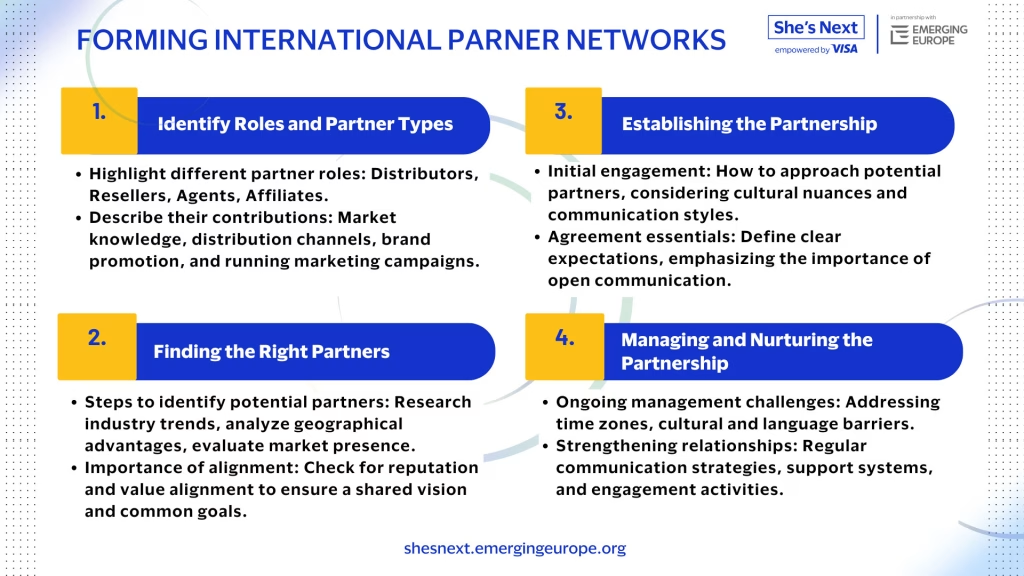
Creating a Global Partner Network
In today’s ever-changing global business world, building partnerships with companies from different countries is a key strategy for growing your business and encouraging new ideas. This means working together with organisations from around the world to achieve common goals.
For women entrepreneurs, these partnerships are not just about entering new markets.
They also help in sharing knowledge, technology, and cultural insights. The benefits are many – from expanding your business to improving your products and making your brand known internationally.
Understanding International Partner Networks
In an international partner network, each member has a specific role to play. Partners bring different strengths to the table, such as knowledge of markets, distribution channels, or customer access.
It is important to know the types of partners you can work with – distributors can help sell your products, resellers can boost sales, agents can promote your brand, and affiliates can run marketing campaigns. Understanding these roles helps you choose the right partnership model for your business.
Identifying Potential Partners
Finding the right partners requires a clear plan. You need to research industry trends, geographical advantages, and the market presence of potential partners. This research gives you insights into how well a partner’s reputation and values match yours.
Choosing the right partner goes beyond numbers; it’s about envisioning a future where both parties trust each other and share common goals.
Establishing Partnerships
Starting a conversation with potential partners requires tact and understanding of different cultures. Building relationships is all about being honest and wanting positive outcomes for everyone involved.
When discussing partnership agreements, it’s crucial to be clear about expectations and contributions from both sides. This sets the tone for the partnership, with open communication being key to successful collaborations.
Managing and Nurturing International Partnerships
Once partnerships are formed, the real work begins. Managing partnerships across borders means dealing with time differences, cultural differences, and language barriers.
Entrepreneurs must overcome these challenges by understanding different business customs and regulations. Regular communication and strong support systems are vital to ensure that all partners feel valued and engaged.
Whether through online meetings or face-to-face interactions, activities that strengthen relationships help solidify successful partnerships.
Cultural Differences and Similarities
Understanding and adapting to cultural differences is vital when building an international partner network.
Let’s dive a bit deeper into the regions you are most likely to be doing business in!
Communication Styles
Eastern Europe: Communication tends to be direct but with a sense of diplomacy. For example, while a Polish entrepreneur might be straightforward in expressing her opinion, she will often do so with tact to maintain good relations.
Central Asia: Indirect communication prevails, focusing on politeness and often using stories or analogies. A Kazakh businessperson might use proverbs or indirect suggestions to convey their message.
Western Europe: Directness and clarity are valued, with less emphasis on formality. A Dutch partner, for instance, will appreciate straight talk and getting to the point quickly.
Middle East: Communication is nuanced and relationship-focused. It’s common for an Emirati executive to engage in lengthy discussions that may not seem directly related to the business at hand as a way to build trust.
USA: Very direct and explicit, with a preference for clear and concise communication. An American might quickly dive into business discussions without much preliminary small talk.
Approach to Business Meetings
Eastern Europe: Meetings are formal and structured, often starting with a clear agenda. In the non-EU countries of the region, it’s typical for meetings to follow a strict order with little deviation from the planned topics.
Central Asia: The formality of meetings can vary, but there’s usually a strong emphasis on hospitality and building personal connections. In Uzbekistan, for example, a meeting might start with tea and traditional snacks as a gesture of welcome.
Western Europe: Generally punctual and structured, with a focus on efficiency. A German business meeting, for instance, would likely start on time and stick closely to the agenda.
Middle East: Meetings may not always start on time, and initial discussions often involve social conversation. In Saudi Arabia, it’s customary to exchange pleasantries and inquire about each other’s well-being before talking business.
USA: Time-efficient and goal-oriented, with an expectation that meetings will start and end on time and cover all points succinctly. Small talk is minimal, and the focus is on action and results.

Negotiation Tactics
Eastern Europe: Pragmatic and cautious, with a tendency to carefully consider all options. A Bulgarian negotiator might take time to weigh the pros and cons before making a commitment.
Central Asia: Negotiations are relationship-driven and may require several meetings to build rapport. A Tajik business leader might prioritise establishing a strong personal connection before discussing terms.
Western Europe: Logical and data-driven, negotiations are typically straightforward with less back-and-forth. A Swedish partner would value clear data and a rational approach to decision-making.
Middle East: Relationship-based and expectant of flexibility, negotiations can be lengthy and require patience. A Qatari counterpart may place great importance on mutual respect and the long-term potential of the partnership.
USA: Assertive and focused on achieving a ‘win-win’ scenario, American entrepreneurs are known for their straightforward negotiation style, often seeking quick resolutions and clear outcomes.
Hierarchy and Decision-Making
Eastern Europe: Hierarchical, with decisions often made by senior leaders. In a Ukrainian company, for example, employees might defer to the authority of their managers rather than voicing their own opinions.
Central Asia: There’s a strong respect for hierarchy, with decisions typically made by the most senior person present. In a Kyrgyz firm, it would be expected that the head of the company has the final say.
Western Europe: Varies by country, but generally less hierarchical than Eastern Europe. In Denmark, for instance, there’s a flatter organisational structure, and employee input is often encouraged.
Middle East: Strong hierarchical structures are prevalent, with top-down decision-making. In Oman, it would be common for the highest-ranking person to make decisions after consulting with advisors.
USA: While there can be hierarchical elements, there’s also a significant emphasis on individual initiative and empowerment. In a Silicon Valley startup, for example, innovative ideas are often welcomed from all levels of the organisation.
Finding Common Ground (anywhere in the world)
Understand and Respect Local Customs: Each region has its own business etiquette and customs. For instance, while gift-giving might be an important part of initiating business in Japan, it could be seen as inappropriate or even illegal in other cultures.
Flexibility and Adaptability: Adapting your approach to fit the local business culture is crucial. This might mean adjusting your negotiation tactics or even your product offerings to better suit the market you’re entering.
Building Relationships: Forming genuine connections is key across all regions. Whether it’s through shared meals in Italy or a breakfast meeting in the US, finding ways to bond outside of the boardroom can cement business relationships.
Language and Communication: While English is commonly used in international business, showing effort in learning key phrases or even conversational language skills in your partner’s native tongue can go a long way in building rapport and demonstrating respect for their culture.
The world offers many opportunities for those who want to expand their business connections.
Creating a global partner network can help take your business to new heights, unlocking new possibilities. It’s a journey of exploration, collaboration, and empowerment.
Embrace the diversity, the differences, the growth, and the opportunities that international partnerships offer — and watch your business grow beyond borders.
Read more about the importance of networking in our Female Entrepreneurship report.
New Free Courses — Made for Ambitious Women Entrepreneurs!
It’s time to grow smarter, adapt faster, and take your business global.
Explore two powerful courses available exclusively to She’s Next members:
The Reinvention Masterclass for Start-up Founders
Beyond Borders: Building for Global Success
Enroll today — it’s free!






Responses